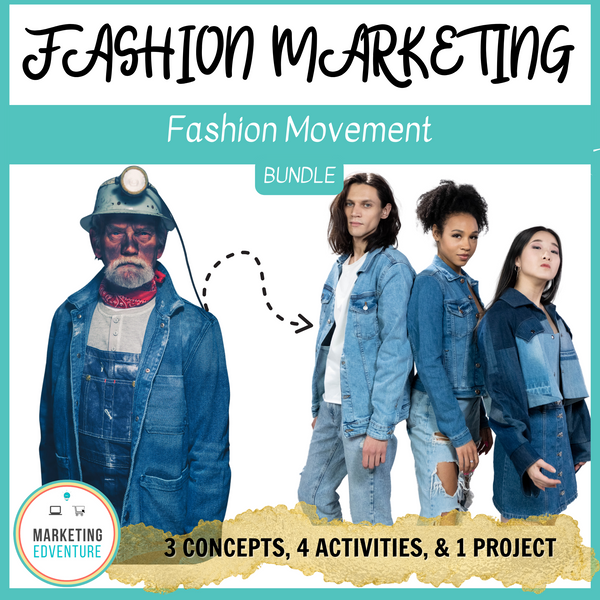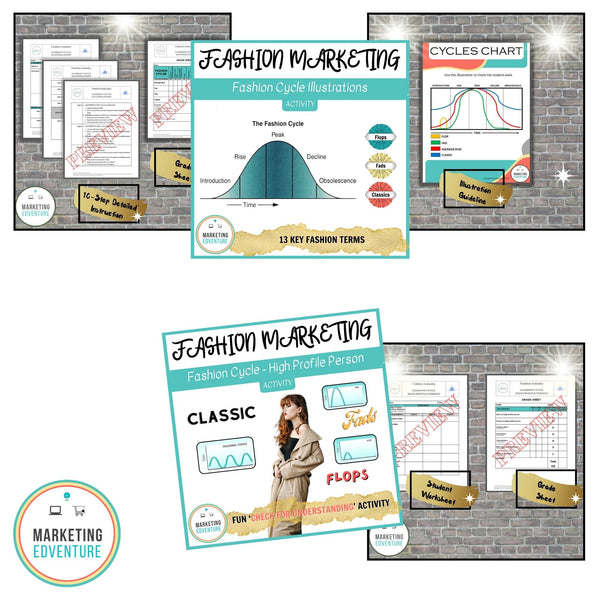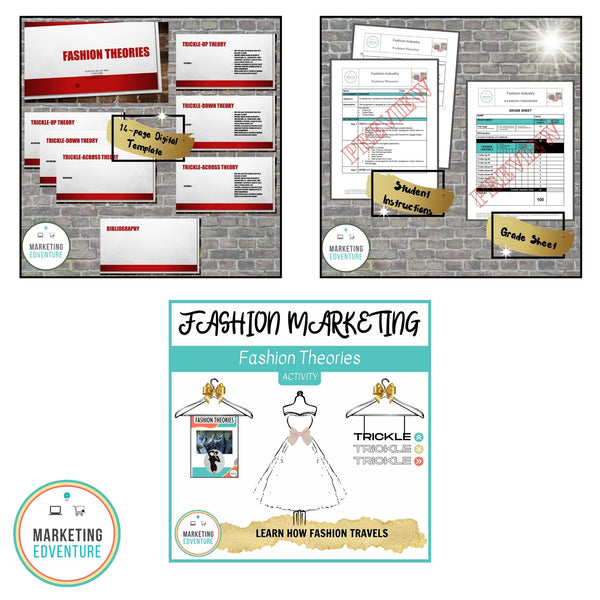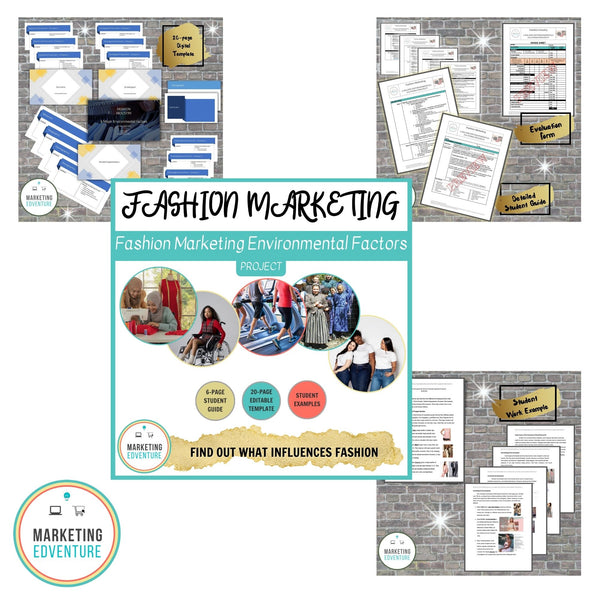1007. Fashion Movement Bundle - Fashion Cycle, Fashion Theories, & Environmental Factors
Every time YOU buy a fashion item, YOU are impacted by, influenced by, or participating in the movement of fashion. It's very key that fashion industry personnel understand the necessity of studying the movement of fashion in order to effectively forecast trends; inform all industry levels; and sell to consumers. This Fashion Movement bundle encompasses 3 concepts that allows students to learn:
- Fashion Cycle - 1) The “Fashion Cycle Illustration” activity is designed for the student to illustrate the FOUR variations of the fashion cycle through all FIVE phases. 2) The “Fashion Cycle – High-profile Person” activity is designed for the student to create a fashion cycle profile of a high-profile person. These people are seen as fashion leaders, and often we can a pulse for how some fashion items are trending by observing these leaders.
- Fashion Theories - 1) The “Fashion Theories” activity objective is for the student to identify the 3 variations of the fashion theories and provide examples following the guideline provided. A template is provided for the student to use as they research and demonstrate their work. 2) Fashion Week, Trend, & Theory Crossword & Word Find Puzzles is a great activity for bellringers, do-nows, quizzes, extra credit, and so much more. These puzzles help students comprehend terminology related to fashion weeks, trends, and theories.
- Environmental Factors - The “Fashion Marketing Environmental Factors Project" is a great project to help students understand the factors and demonstrate their knowledge. It's designed to help the student RESEARCH and DESCRIBE the 4 major environmental factors that affect fashion interest and demand. Students will take a deep dive look into the 4 factors Market Segmentation, Economic Environment, Sociological Environment, and Psychological Environment in the fashion industry. Using the provided template, they will document their findings.
TIME
This bundle is designed to span a 3-week period.
Each activity can be done in 1 or 2 class periods based on your bell schedule. The project time is inclusive of research and development of a presentation. Suggested classroom time for the project is at least 135 minutes each week for research, collaboration, and observation.
PRODUCT CONTENT
- Fashion Cycle Illustration
- 3-page Instructional Handout
- Grading Sheet
- Illustration Chart
- Fashion Cycle Person
- Instructional Handout
- Worksheet
- Grading Sheet
- Fashion Theories Crossword & Word Find Puzzles
- Instructional Handout
- Word Find
- Crossword Puzzle
- Answer Sheets
- Fashion Theories Activity
- Instructional Handout
- Digital Template
- Grading Sheet
- Fashion Marketing Environmental Project
- Instructional Handout
- Digital Template
- Grading Sheet
- Student Example
MARKETING STANDARDS
TEKS
130.383. Fashion Marketing
(2) The student knows the importance and functions of marketing. The student is expected to:
- (C) research trends affecting fashion marketing.
(4) The student demonstrates the use of oral and written communication skills in creating, expressing, and interpreting information and ideas, including technical terminology and information.
(5) The student knows that distribution channel members facilitate the movement of products. The student is expected to:
- (A) explain channels of distribution for fashion products; and
- (B) describe activities of each channel member in the fashion industry.
(9) The student knows that a successful marketer must communicate information on retail products, services, images, and ideas to achieve a desired outcome. The student is expected to:
- (A) demonstrate methods of advertising to communicate promotional messages to targeted audiences;
- (B) use special events to increase sales;
- (C) display visual merchandising techniques to increase interest in product offerings;
- (D) implement display techniques to attract customers and increase sales potential; and
- (E) manage promotional activities to maximize return on promotional efforts.
(11) The student demonstrates an understanding of concepts and actions to determine client needs and wants. The student is expected to:
- (A) acquire product knowledge to communicate product benefits and to ensure appropriateness of product for the customer;
(12) The student knows the nature and scope of fashion. The student is expected to:
- (A) explain the importance of fashion;
- (B) demonstrate knowledge of fashion history and how it relates to today's fashions;
- (C) distinguish among fashion terms such as fashion, style, and design;
- (E) research fashion information;
- (D) list major environmental influences on fashion demand;
- (F) explain legislation that impacts the fashion industry; and
- (G) describe how international marketing has affected the fashion industry.
(13) The student knows that a career in fashion marketing requires knowledge of the industry. The student is expected to:
- (A) research careers in the fashion industry.
- (B) list and describe businesses related to the fashion industry.
Become a part of the Marketing EdVenture®️ community clicking each link below and following.
TERMS OF USE
By purchasing this resource, you are agreeing that the contents are the property of Marketing EdVenture®️, owned by Jacqueline P. Walker, and licensed to you only for classroom/personal use as a single user. I retain the copyright and reserve all rights to this product.
Thanks so much for spending a moment of your time with me. I look forward to more engagement.
Have a wonderfully blessed day,
Jacqueline P. Walker
Marketing EdVenture®️








